ASUS P8Z68-V PRO Review: Our First Z68 Motherboard
by Ian Cutress on May 11, 2011 3:13 AM EST- Posted in
- Motherboards
- Asus
- Z68
3D Movement Algorithm Test
The first benchmark ran is actually one I have written. My full time job involves computational chemistry, so this first benchmark uses various algorithms for three-dimensional simulation and movement of independent particles. The algorithms both employ uniform random number generation or normal distribution random number generation, and vary in various amounts of trigonometric operations, conditional statements, generation and rejection, fused operations, etc. The benchmark runs through six algorithms for a specified number of particles and steps, and calculates the speed of each algorithm, then sums them all for a final score. This is an example of a real world situation that a computational scientist may find themselves in, rather than a pure synthetic benchmark. The benchmark is also parallel between particles simulated, and we test the single thread performance as well as the multi-threaded performance.
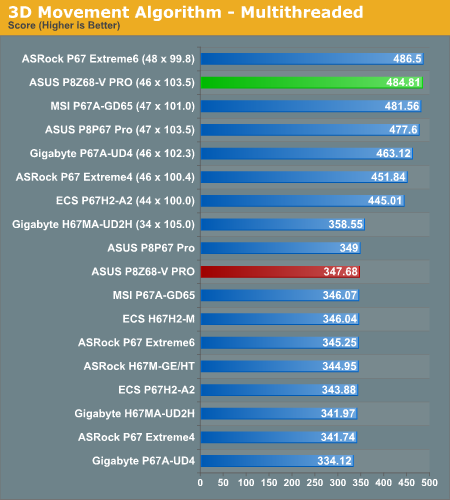
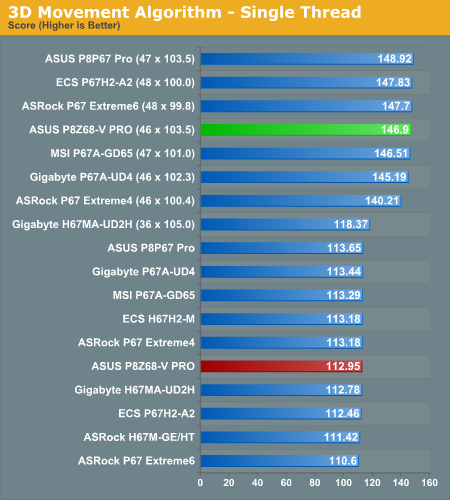
WinRAR x64 3.93
With 64-bit WinRAR, we compress the set of files used in the USB speed tests. WinRAR x64 3.93 attempts to use multithreading when possible.
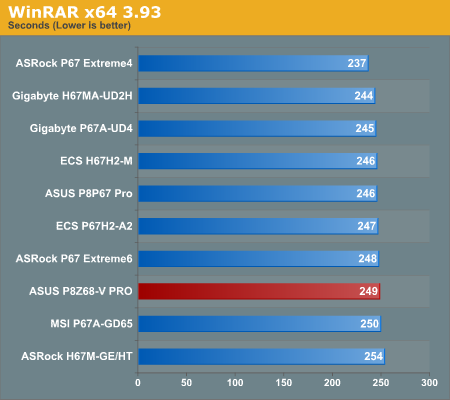
FastStone Image Viewer 4.2
FastStone Image Viewer is a free piece of software I have been using for quite a few years now. It allows quick viewing of flat images, as well as resizing, changing color depth, adding simple text or simple filters. It also has a bulk image conversion tool, which we use here. The software currently operates only in single-thread mode, which should change in later versions of the software. For this test, we convert a series of 170 files, of various resolutions, dimensions and types (of a total size of 163MB), all to the .gif format of 640x480 dimensions.
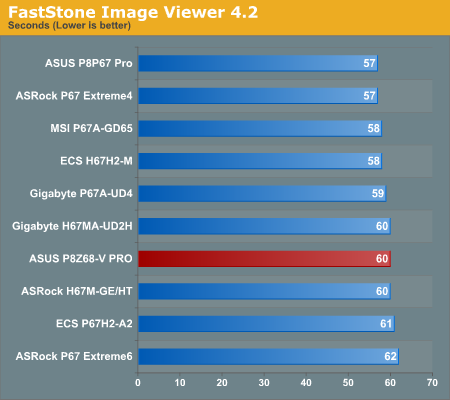
Sorenson Squeeze 6.0
Sorenson Squeeze is a professional video encoder, complete with a vast array of options. For this test, we convert 32 HD videos, each a minute long and approximately 42 MB in size, to WMV 512KBps format. Squeeze can encode multiple videos at once, one for each thread.
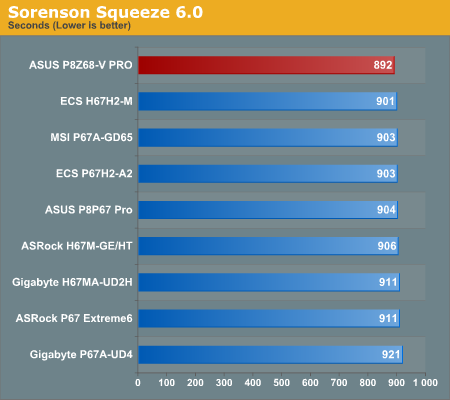
The ASUS does relatively well in our Computation bench suite, with an excellent Squeeze score. It's not the fastest board so far, but the difference between the slowest and fastest board in each test is only 3-9%, so for stock performance it's not something generally noticeable in day to day use.










95 Comments
View All Comments
fr500 - Thursday, May 12, 2011 - link
Not any new crashes but there are crashes now and them with certain nvidia driver versions on TF2 for instance. With an aditional layer on top it makes it worse I guess...Also I said that about control panels because of techreport's review but it seems they didn't know about d mode
AnnihilatorX - Thursday, May 12, 2011 - link
Anand noted that Intel said (when virtu didn't exist), to use QuickSync in Z68, one needs to use 2 monitors.So basically you can have 2 separate monitors, one connection from discrete and one from onboard.
L. - Thursday, May 12, 2011 - link
I'm pretty sure you can come up with more complex and useless examples of using relatively bad technology, namely Lucid.As long as you have a real gpu, you should not be using the IGP at all, that is not going to change anytime soon as 7% of a real GPU >>> anything Intel ever made.
Not to worry though, Virtu will be gone very soon, like Hydra.
"Normally", you should be able to send the transcoding to your GPU and have 3d / screen input at the same time.
In other words : intel IGP bad except if you don't have anything else, virtu bad always unless your GPU is really bad too (wtf?).
This will become more interesting when AMD starts selling Llano, as llano's gpu will be much stronger than Intel's IGP and using both ressources efficiently (discrete+igp) will make a real difference.
fr500 - Thursday, May 12, 2011 - link
The whole deal with this is QuickSync is really fast for transcoding.I don't like the idea of Hydra either so I think using a spare input from your monitor could work, it would still be detected even if the input is not the current active one and even if it doesn't get detected you could just select the other input, do your transcoding and be done with it.
cbgoding - Wednesday, May 11, 2011 - link
So 1.42V was your safe limit, but under load it jumped to 1.544 V?What the hell?
AnnihilatorX - Thursday, May 12, 2011 - link
He wrote 'but'. He's suggesting a bug in the TurboV softwarecbgoding - Friday, May 13, 2011 - link
alright, makes sense. Guess I'll never use TurboV, I'd shit a brick if i had a .124V spike.L. - Thursday, May 12, 2011 - link
My mobo does that ... although I went a bit hard on the pencilmod on purpose - which gives me a vload > vidle (although very close, it's about .025 more).DBissett - Thursday, May 12, 2011 - link
Sorry for grammar policing but some grammar is so bad it makes reading otherwise good articles impossible. "Asus" and "Intel" are companies, singular nouns, and require singular verbs. To say "Asus have" and "Intel have" is not only technical incorrect but just plain reads very badly. "Asus has...." and "Intel has...." is the correct grammatical form. Or if you have to use plural verbs then try "People at Asus have..." for example, and now you've got a plural subject.Dave
IanCutress - Friday, May 13, 2011 - link
Hi Dave,This is one of the (many) differences between British and American English. I attempt to write in an American style for AnandTech, but as I am British, a few things scrape through the net.
All the best,
Ian